17-19 oct 2025
APK Portugal :
Congrès de l'APK 2025
16-18 mai 2025
SEK Espagne :
Congrès de la SEK 2025
29 mai - 1 juin
Allemagne DKG :
Congrès de la DKG 2025
21-22 juin 2025
AIK Italie :
Congrès de l'AIK 2025
12-14 sep 2025
SKS Suède, Danemark, Finlande :
Congrès de la SKS 2025
26-28 sep 2025
KCF France :
51ème congrès du KCF
17-19 oct 2025
APK Portugal :
Congrès de l'APK 2025
16-18 mai 2025
SEK Espagne :
Congrès de la SEK 2025
29 mai - 1 juin
Allemagne DKG :
Congrès de la DKG 2025
21-22 juin 2025
AIK Italie :
Congrès de l'AIK 2025
12-14 sep 2025
SKS Suède, Danemark, Finlande :
Congrès de la SKS 2025
26-28 sep 2025
KCF France :
51ème congrès du KCF
17-19 oct 2025
APK Portugal :
Congrès de l'APK 2025
Fermer 
Accueil
Qu'est ce que le KCF ?
Les sections régionales
Les congrès du KCF
Contacter le KCF
L'agenda du KCF
Les liens du KCF
Challenge Européen Killiphile
Débuter avec les killies
Les actualités du KCF
Interviews d'éleveurs
Bricolage et astuces
Nourriture
Voyages / Expéditions Killi Expert
Annonces
Voyages / Expéditions Killi Expert
- Accueil
- Le forum du KCF
- Bricolage, installations, trucs et astuces
- Une crevette de l'Orient (Pt1)
Une crevette de l'Orient (Pt1)
Bricolage, installations, trucs et astuces

Le 25 avril 2011 à 11h45

BigC
Le 25 avril 2011 à 11h45
[center][b][size=14pt]Culturing Branchinella thailandensis[/size][/b][/center]
[center]A Shrimp from the Orient
by
BigC[/center]
[center]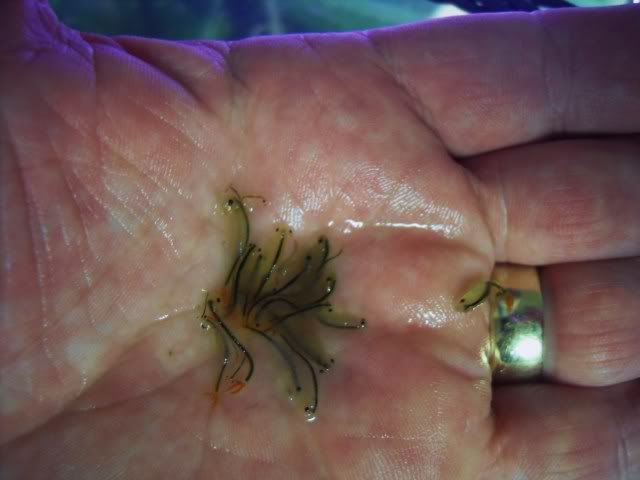 [/center]
[/center]
[center][i][b]Adult Thai Fairy Shrimp[/b][/i][/center]
[center]This lengthy editorial was constructed by myself due to the sheer lack of non technical reference material available to the hobbyist regarding this interesting subject matter. I've scoured the internet for hours on end for relevant data that I could use and I only managed to find somewhat sketchy articles of which only just brushed on the topic. So as an endeavour to try and help other aquarists and folks interested in home aqua-culturing such creatures I have managed to put together something based solely on my personal experience. I hope you enjoy what I have managed to unearth.
***************[/center]
This being a new venture for me and for anyone that knows me will impart that I like to culture live foods at home if possible, in an effort to give my fish a different and diverse dietary range to satisfy their everyday bodily needs. Borne out of the simplistic idea that brine shrimp need brine water, a salty mix within a specific gravity range to thrive and grow and we are predominately using freshwater as a medium for our fish which is an alien environment for Artemia to survive much longer than an hour or so. Subsequently Artemia do not live very long in freshwater tanks or fry tubs, leading to the fouling of the water which could, if left, lead to disease with resultant fish and fry losses. Thai Fairy Shrimp on the other hand would possibly fill this gap. offering me a high protein, low fat food source that would stick around longer in a freshwater environment giving fish and fry a longer time to catch and consume this fresh food source before ending up as a useless mush on the aquarium floor.
Lots of aquarists would like to give this type of food source a go, but shy away from attempts to home culture this small Crustacea species due to the fear of being duped by unscrupulous Thai vendors sending unreliable cysts through the lengthy postal delivery system. So this little article is set out with a two fold agenda, firstly to catalogue my attempts at culturing and sustaining the shrimp to subsequent populations and secondly to dispel the fear of ordering cysts from the Far East.
I'm not a fool... so realistically I would not be able to produce shrimp cysts in such numbers as to be in a position to distribute large quantities around the country. (I don't have a lake in my back yard) what I am aiming for here is to produce enough shrimp and cysts with a little effort to be able to have a self sustainable food source for both fish and fry feeding. The initial program will be primarily to grow the shrimp to adulthood and collect the cysts, this would be the number one priority. To forget about feeding anything to the fish initially until I have enough cysts to sustain future generations.
An adult of 35mm would be of no use to myself as I only keep and breed small Killifish species so for food purposes I would be only using perhaps the 1st, 2nd and 3rd instars.
[center]As I stated earlier this is a new venture for me, a step into uncharted waters as it were. I will catalogue all my successes and failures pictorially within this thread in my usual manner, so lets now see where this will take us. [/center]
[i][b]What are Fairy Shrimp?[/b][/i]
There are many species of fairy shrimp catalogued geographically around our planet, some small, some huge, but for the subject of this particular article I will be concentrating on a relatively small species from Thailand.[b]Branchinella thailandensis.[/b]
According to published literature Branchinella thailandensis have been found in the northeastern part of Thailand since 2002. This species can potentially serve as live feed for fish and crustaceans in aquaculture because of its high nutritional value; 64.94% protein, 5.07% fat, 17.96%. carbohydrate, 8.49% ash, providing an alternative to artemia (56.4% protein, 11% fat, 12.1%. carbohydrate and 17.4% ash)
(Figures given suggest that they are of a much higher nutritional value than our other most common freshwater food resource, Daphnia).
[center][b]Order[/b] Anostraca [b] Class[/b] Branchiopoda[b] Sub-phylum[/b] Crustacea[b] Phylum[/b] Arthropoda[/center]
The shrimp have adapted to living in shallow vernal pools, prone to drying out on occasion as the seasons predict. The female lays hard cased eggs (similar to Artemia cysts) that will lie dormant in the dry substrate until the pool floods once again. From cyst to adult they go through several [acronym='Development stages or moults'][color="#FF0000"]instars[/color][/acronym]. Culminating in mating and subsequent egg laying. The lifecycle of the fairy shrimp takes roughly about 6-8 weeks depending on temperature and food resources. Expect the adults reach a size of between 25 to 35mm in this short time-frame. Fairy Shrimp are filter feeders and can comsume wide range of food within the water column such as bacteria, protozoa, algae, rotifer and organic matter. As normal with this family of crustacean they are very sensitive to adverse changes in water conditions and chemicals.
[i][b]Acquisition of Cysts;[/b][/i]
[center]I initially acquired the cysts from a "Buy Now" auction on Ebay from a vendor (with 100% creditable feedback) from Thailand. Reportedly I would receive 60,000 cysts for my money. The transaction went really well with much dialogue between myself and the vendor. The packet arrived after about 7 days in transit. It contained 3 capsules of shrimp eggs sealed in a foil bag. (See pics below)[/center]
[center]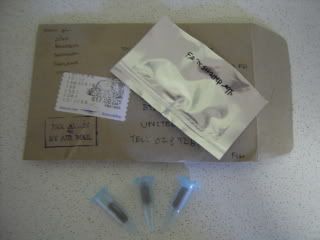
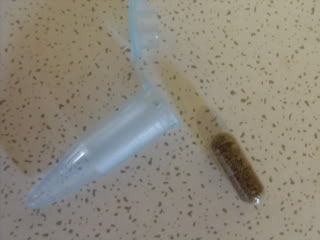 [/center]
[/center]
[center][i][b]The actual packaging for the fairy shrimp cysts from Thailand[/b][/i][/center]
Although the vendor states in his literature that he cannot be responsible for hatching rates etc, I figure I should have enough cysts and hopefully subsequent shrimp to get me to the next stage. Which ultimately would be to raise as many shrimp as possible to adulthood and collect the eggs they produce.
[i][b]Aquaculturing;[/b][/i]
As with all my articles, the findings therein this particular study is purely gathered from my own experiences on the subject matter. Many aquarists may find different methods in order to gain equal or higher success rates or yields. I call upon those people to make comments and offer positive suggestions surrounding this material so as others may share and educate themselves by reading these editorials.
[list]
[*][b]The Container;[/b]
The first containers, like everything else are just standard jars and tubs rather than specialist dedicated vessels specifically designed for the job in hand. Initially I set up the cultures almost identical to my internal culturing of Daphnia pulex, in fact everything is essentially the same or similar. Later as the shrimp grow on towards adulthood I will move them into a proper all glass aquarium with a view to collecting the eggs.
[center]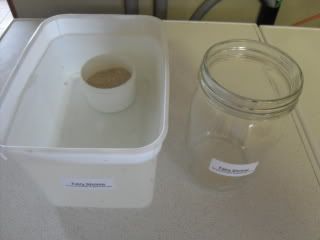
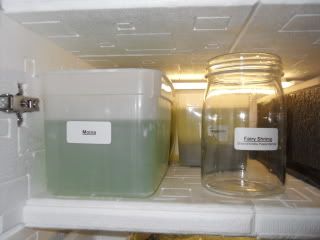
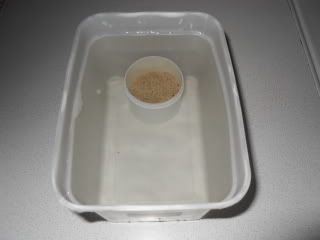
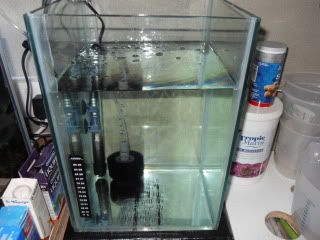
[/center]
[center][i][b]The containers I utilise for culturing Fairy Shrimp.[/b][/i][/center]
When first setting up all of the vessels they have to be sterilised with a very mild bleach solution after which they were thoroughly rinsed with fresh water and meticulousness dried out. If you are attempting to culture these crustaceans sometime in the future don't be tempted to use other chemical washing-up liquids to clean your containers as the residue they leave behind will kill the shrimp.
[*][b]The Water;[/b]
The water I use for the shrimp is nothing fancy, just rainwater in a clean sterile container with the pH adjusted to 7.6. by means of Bicarbonate of Soda. The temperature is kept at around 22'C. Added to the set-up is a small tub of Aragonite sand to help keep the pH up.
[*][b]The Cysts;[/b]
You can differentiate Branchinella thailandensis cysts from other fairy shrimp in the region just by observing the shape of their eggs casings. Thai fairy shrimp cysts are spherical with many irregular six sided indentations or dimples around its circumference. (see pic below)
[center]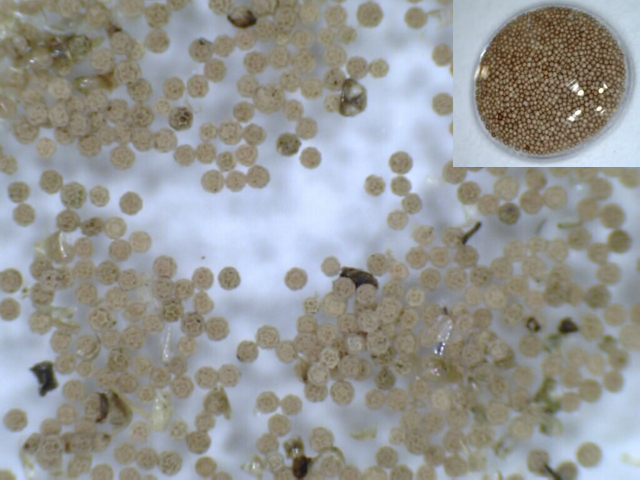 [/center]
[/center]
[b][center][b]Branchinella thailandensis cysts under 200x magnification.[/b]([i]Artemia insert[/i])[/center]
You can see just by looking at the egg casings that they also differ from Artemia cysts ([i]see insert[/i]) in that the casing is rough, heavily dimpled and not as smooth and uniform as the Brineshrimp cyst.
[*][b]Hatching;[/b]
Now we come to the first step on our journey, the initial hatching of the first batch of cysts. I have used a whole capsule of eggs for this initial wetting. It is known from literature that all eggs must sink to the bottom in order for them to hatch. Floating eggs wont hatch by all accounts. You can use some coffee filter papers laid on top of the floating cysts to get them to absorb more water and help them to submerge. Any cysts that still manage to float you can re-dry (see later in thread) and hatch at a later stage for more shrimp
[center]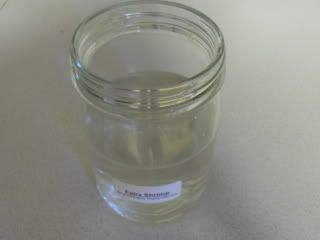
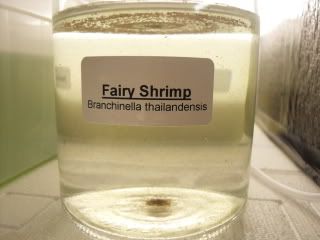 [/center]
[/center]
[center][i][b](i)The hatching jar. (ii) All viable eggs must sink!!![/b][/i][/center]
The cysts will immediately begin to absorb water, and will eventually sink to the bottom of the jar. The baby shrimp will not hatch straight away until they are convinced that the water body is permanent. This will take about 24 to 48 hours, sometimes longer, depending on conditions. After the allotted time the nauplii will hatch and begin swimming with jerky movements as they propel themselves through the water column. The do not need to be fed until the second day. They are very small and a small (20x) lens or eye loupe will help you to see them much better. They are "photo-tropic" so if you shine a beam of light through the jar they will congregate near the light source and will be more visible. Unlike brineshrimp vigorous agitation of the water is not required to trigger fairy shrimp to hatch.
[/list]
[center][color=red]Part 2[/color] - http://www.killiclubdefrance.org/forum/index.php?topic=5239.0[/center]
[center]A Shrimp from the Orient
by
BigC[/center]
[center]
 [/center]
[/center][center][i][b]Adult Thai Fairy Shrimp[/b][/i][/center]
[center]This lengthy editorial was constructed by myself due to the sheer lack of non technical reference material available to the hobbyist regarding this interesting subject matter. I've scoured the internet for hours on end for relevant data that I could use and I only managed to find somewhat sketchy articles of which only just brushed on the topic. So as an endeavour to try and help other aquarists and folks interested in home aqua-culturing such creatures I have managed to put together something based solely on my personal experience. I hope you enjoy what I have managed to unearth.
***************[/center]
This being a new venture for me and for anyone that knows me will impart that I like to culture live foods at home if possible, in an effort to give my fish a different and diverse dietary range to satisfy their everyday bodily needs. Borne out of the simplistic idea that brine shrimp need brine water, a salty mix within a specific gravity range to thrive and grow and we are predominately using freshwater as a medium for our fish which is an alien environment for Artemia to survive much longer than an hour or so. Subsequently Artemia do not live very long in freshwater tanks or fry tubs, leading to the fouling of the water which could, if left, lead to disease with resultant fish and fry losses. Thai Fairy Shrimp on the other hand would possibly fill this gap. offering me a high protein, low fat food source that would stick around longer in a freshwater environment giving fish and fry a longer time to catch and consume this fresh food source before ending up as a useless mush on the aquarium floor.
Lots of aquarists would like to give this type of food source a go, but shy away from attempts to home culture this small Crustacea species due to the fear of being duped by unscrupulous Thai vendors sending unreliable cysts through the lengthy postal delivery system. So this little article is set out with a two fold agenda, firstly to catalogue my attempts at culturing and sustaining the shrimp to subsequent populations and secondly to dispel the fear of ordering cysts from the Far East.
I'm not a fool... so realistically I would not be able to produce shrimp cysts in such numbers as to be in a position to distribute large quantities around the country. (I don't have a lake in my back yard) what I am aiming for here is to produce enough shrimp and cysts with a little effort to be able to have a self sustainable food source for both fish and fry feeding. The initial program will be primarily to grow the shrimp to adulthood and collect the cysts, this would be the number one priority. To forget about feeding anything to the fish initially until I have enough cysts to sustain future generations.
An adult of 35mm would be of no use to myself as I only keep and breed small Killifish species so for food purposes I would be only using perhaps the 1st, 2nd and 3rd instars.
[center]As I stated earlier this is a new venture for me, a step into uncharted waters as it were. I will catalogue all my successes and failures pictorially within this thread in my usual manner, so lets now see where this will take us. [/center]
[i][b]What are Fairy Shrimp?[/b][/i]
There are many species of fairy shrimp catalogued geographically around our planet, some small, some huge, but for the subject of this particular article I will be concentrating on a relatively small species from Thailand.[b]Branchinella thailandensis.[/b]
According to published literature Branchinella thailandensis have been found in the northeastern part of Thailand since 2002. This species can potentially serve as live feed for fish and crustaceans in aquaculture because of its high nutritional value; 64.94% protein, 5.07% fat, 17.96%. carbohydrate, 8.49% ash, providing an alternative to artemia (56.4% protein, 11% fat, 12.1%. carbohydrate and 17.4% ash)
(Figures given suggest that they are of a much higher nutritional value than our other most common freshwater food resource, Daphnia).
[center][b]Order[/b] Anostraca [b] Class[/b] Branchiopoda[b] Sub-phylum[/b] Crustacea[b] Phylum[/b] Arthropoda[/center]
The shrimp have adapted to living in shallow vernal pools, prone to drying out on occasion as the seasons predict. The female lays hard cased eggs (similar to Artemia cysts) that will lie dormant in the dry substrate until the pool floods once again. From cyst to adult they go through several [acronym='Development stages or moults'][color="#FF0000"]instars[/color][/acronym]. Culminating in mating and subsequent egg laying. The lifecycle of the fairy shrimp takes roughly about 6-8 weeks depending on temperature and food resources. Expect the adults reach a size of between 25 to 35mm in this short time-frame. Fairy Shrimp are filter feeders and can comsume wide range of food within the water column such as bacteria, protozoa, algae, rotifer and organic matter. As normal with this family of crustacean they are very sensitive to adverse changes in water conditions and chemicals.
[i][b]Acquisition of Cysts;[/b][/i]
[center]I initially acquired the cysts from a "Buy Now" auction on Ebay from a vendor (with 100% creditable feedback) from Thailand. Reportedly I would receive 60,000 cysts for my money. The transaction went really well with much dialogue between myself and the vendor. The packet arrived after about 7 days in transit. It contained 3 capsules of shrimp eggs sealed in a foil bag. (See pics below)[/center]
[center]

 [/center]
[/center][center][i][b]The actual packaging for the fairy shrimp cysts from Thailand[/b][/i][/center]
Although the vendor states in his literature that he cannot be responsible for hatching rates etc, I figure I should have enough cysts and hopefully subsequent shrimp to get me to the next stage. Which ultimately would be to raise as many shrimp as possible to adulthood and collect the eggs they produce.
[i][b]Aquaculturing;[/b][/i]
As with all my articles, the findings therein this particular study is purely gathered from my own experiences on the subject matter. Many aquarists may find different methods in order to gain equal or higher success rates or yields. I call upon those people to make comments and offer positive suggestions surrounding this material so as others may share and educate themselves by reading these editorials.
[list]
[*][b]The Container;[/b]
The first containers, like everything else are just standard jars and tubs rather than specialist dedicated vessels specifically designed for the job in hand. Initially I set up the cultures almost identical to my internal culturing of Daphnia pulex, in fact everything is essentially the same or similar. Later as the shrimp grow on towards adulthood I will move them into a proper all glass aquarium with a view to collecting the eggs.
[center]




[/center]
[center][i][b]The containers I utilise for culturing Fairy Shrimp.[/b][/i][/center]
When first setting up all of the vessels they have to be sterilised with a very mild bleach solution after which they were thoroughly rinsed with fresh water and meticulousness dried out. If you are attempting to culture these crustaceans sometime in the future don't be tempted to use other chemical washing-up liquids to clean your containers as the residue they leave behind will kill the shrimp.
[*][b]The Water;[/b]
The water I use for the shrimp is nothing fancy, just rainwater in a clean sterile container with the pH adjusted to 7.6. by means of Bicarbonate of Soda. The temperature is kept at around 22'C. Added to the set-up is a small tub of Aragonite sand to help keep the pH up.
[*][b]The Cysts;[/b]
You can differentiate Branchinella thailandensis cysts from other fairy shrimp in the region just by observing the shape of their eggs casings. Thai fairy shrimp cysts are spherical with many irregular six sided indentations or dimples around its circumference. (see pic below)
[center]
 [/center]
[/center][b][center][b]Branchinella thailandensis cysts under 200x magnification.[/b]([i]Artemia insert[/i])[/center]
You can see just by looking at the egg casings that they also differ from Artemia cysts ([i]see insert[/i]) in that the casing is rough, heavily dimpled and not as smooth and uniform as the Brineshrimp cyst.
[*][b]Hatching;[/b]
Now we come to the first step on our journey, the initial hatching of the first batch of cysts. I have used a whole capsule of eggs for this initial wetting. It is known from literature that all eggs must sink to the bottom in order for them to hatch. Floating eggs wont hatch by all accounts. You can use some coffee filter papers laid on top of the floating cysts to get them to absorb more water and help them to submerge. Any cysts that still manage to float you can re-dry (see later in thread) and hatch at a later stage for more shrimp
[center]

 [/center]
[/center][center][i][b](i)The hatching jar. (ii) All viable eggs must sink!!![/b][/i][/center]
The cysts will immediately begin to absorb water, and will eventually sink to the bottom of the jar. The baby shrimp will not hatch straight away until they are convinced that the water body is permanent. This will take about 24 to 48 hours, sometimes longer, depending on conditions. After the allotted time the nauplii will hatch and begin swimming with jerky movements as they propel themselves through the water column. The do not need to be fed until the second day. They are very small and a small (20x) lens or eye loupe will help you to see them much better. They are "photo-tropic" so if you shine a beam of light through the jar they will congregate near the light source and will be more visible. Unlike brineshrimp vigorous agitation of the water is not required to trigger fairy shrimp to hatch.
[/list]
[center][color=red]Part 2[/color] - http://www.killiclubdefrance.org/forum/index.php?topic=5239.0[/center]

Le 26 avril 2011 à 21h05

Nikho
Le 26 avril 2011 à 21h05
Voila le copier/coller de la traduction google sans corrections...
Ce long éditorial a été construit par moi-même en raison de l'absence pure et simple de documents de référence non techniques à la disposition des amateurs à ce sujet intéressant sujet. J'ai écumé l'Internet pendant des heures pour les données pertinentes que je pourrais utiliser et je n'ai réussi à trouver des articles assez sommaire qui ne fait que brossé sur le sujet. Donc, comme un effort pour essayer d'aider d'autres aquariophiles et les gens intéressés par la maison d'aqua-culture de telles créatures, j'ai réussi à monter quelque chose uniquement fondée sur mon expérience personnelle. J'espère que vous apprécierez ce que j'ai réussi à dénicher.
Ceci étant une nouvelle aventure pour moi et pour tous ceux qui me connaissent répandre que je tiens à la culture des aliments en direct à la maison si possible, dans un effort pour donner à mon poisson une autre gamme et la diversité alimentaire pour satisfaire leurs besoins quotidiens des lésions corporelles. Borne de l'idée simpliste que crevette de saumure saumure ont besoin d'eau, un mélange salé dans une plage de densité de prospérer et de croître et nous sommes principalement à l'aide d'eau douce comme un moyen pour notre poisson qui est un environnement étranger pour Artemia pour survivre beaucoup plus longtemps qu'un heure ou deux. Par la suite Artemia ne vivent pas très longtemps dans les réservoirs d'eau ou des bacs à frire, conduisant à l'encrassement de l'eau qui pourrait, à défaut, conduire à la maladie avec le poisson et les pertes résultant des alevins. Thai Fairy crevettes d'autre part ne peut combler cette lacune. m'offrant une haute teneur en protéines, faible source de nourriture grasse qui collait plus longtemps dans un milieu d'eau douce donner du poisson et les alevins plus de temps à pêcher et de manger cette source de nourriture fraîche avant de se retrouver comme une bouillie inutile sur le sol d'aquarium.
Beaucoup d'aquariophiles voudrais donner ce type de source de nourriture un aller, mais répugnent à les tentatives de culture d'origine cette petite espèce crustacés en raison de la crainte d'être dupés par des vendeurs peu scrupuleux Thai envoi kystes peu fiables par le système de distribution du courrier de longue durée. Alors ce petit article est fixé avec un ordre du jour deux fois, d'abord au catalogue mes tentatives de culture et le maintien de la crevette aux populations et d'autre part suite à dissiper la crainte de commander les kystes de l'Extrême-Orient.
Je ne suis pas un imbécile ... de manière aussi réaliste que je ne serait pas en mesure de produire des kystes de crevettes en si grand nombre pour être en mesure de distribuer de grandes quantités à travers le pays. (Je n'ai pas un lac dans ma cour arrière) ce que je vise ici est de produire des crevettes et des kystes assez avec un peu d'efforts pour être en mesure d'avoir une source de nourriture auto durable tant pour le poisson et l'alimentation des alevins. Le programme initial sera principalement d'augmenter la crevette à l'âge adulte et de recueillir les kystes, ce serait la priorité numéro un. Pour oublier quoi que ce soit sur l'alimentation pour les poissons d'abord jusqu'à ce que j'aie assez de kystes à soutenir les générations futures.
Un adulte de 35 mm serait d'aucune utilité pour moi que je ne garde et de petite race espèces barré alors à des fins alimentaires, je serais peut-être en utilisant uniquement le 1er, 2ème et 3ème stades.
Comme je l'ai dit plus haut c'est une nouvelle aventure pour moi, une étape dans des eaux inconnues pour ainsi dire. Je vais catalogue tous mes réussites et les échecs imagée de ce fil dans ma manière habituelle, permet donc maintenant voir où cela nous mènera.
Quelles sont les crevettes de fées?
Il existe plusieurs espèces de crevettes de fées catalogué géographiquement autour de notre planète, certains petits, certains énorme, mais pour le sujet de cet article particulier, je vais concentrer sur une espèce relativement petite de thailandensis Thailand.Branchinella.
Selon la littérature publiée thailandensis Branchinella ont été trouvés dans la partie nord de la Thaïlande depuis 2002. Cette espèce peut potentiellement servir de nourriture vivante pour les poissons et crustacés de l'aquaculture en raison de sa haute valeur nutritionnelle; protéines 64,94%, 5,07% de matières grasses, 17,96%. hydrates de carbone, 8,49% de cendres, offrant une alternative aux artémias (56,4% de protéines, 11% de matières grasses, 12,1%. hydrates de carbone et 17,4% de cendres)
(Les chiffres donnés montrent qu'ils sont d'une grande valeur nutritive plus élevée que nos ressources en eau douce les plus courantes d'autres aliments, les daphnies).
Commandez Anostraca Classe Branchiopoda Sous-phylum Crustacea Phylum des arthropodes
Les crevettes se sont adaptés à la vie en eaux peu profondes mares printanières, sujettes au dessèchement, à l'occasion au fil des saisons prévoir. La femelle pond des œufs durs tubé (semblables à des kystes d'Artemia) qui sommeillent dans le substrat sécher jusqu'à ce que la piscine une fois de plus les inondations. Du kyste à l'âge adulte, ils passent par [color = "# FF0000"] plusieurs stades [/ color]. Culminant dans l'accouplement et la pose ultérieure d'oeuf. Le cycle de vie de la crevette de fées prend approximativement environ 6-8 semaines en fonction des ressources de température et de la nourriture. Attendez-vous les adultes atteignent une taille comprise entre 25 à 35mm dans ce laps de temps court. Fairy crevettes se nourrissent par filtration et peut comsume large éventail de produits alimentaires au sein de la colonne d'eau tels que les bactéries, protozoaires, les algues, rotifères et de matière organique. Comme d'habitude avec cette famille de crustacés qu'ils sont très sensibles à des changements défavorables dans les conditions de l'eau et des produits chimiques.
Acquisition des kystes;
J'ai d'abord acquis les kystes d'un "Achat immédiat" aux enchères sur Ebay auprès d'un fournisseur (avec commentaires admissibles à 100%) en provenance de Thaïlande. Il semblerait que je recevrais 60.000 kystes pour mon argent. L'opération s'est très bien passé avec beaucoup de dialogue entre moi et le vendeur. Le paquet est arrivé après environ 7 jours en transit. Il contient 3 capsules d'oeufs de crevettes scellé dans un sac de papier. (Voir photos ci-dessous)
L'emballage réels pour les kystes de fées crevettes en provenance de Thaïlande
Bien que le fournisseur dans sa documentation qu'il ne peut pas être responsable des taux d'éclosion, etc, je me dis que j'aurais assez de kystes et de crevettes, espérons suite à me faire à l'étape suivante. Qui a finalement serait de relever que les crevettes que possible à l'âge adulte et de recueillir les œufs qu'elles produisent.
Aquaculturing;
Comme pour tous mes articles, les résultats de cette étude particulière qui y est purement recueillies auprès de mes propres expériences sur le sujet. De nombreux aquariophiles peuvent trouver des méthodes différentes afin d'obtenir des taux de réussite égal ou supérieur ou des rendements. J'appelle les gens à faire des commentaires et des suggestions positives qui entourent cette matière ainsi que d'autres peuvent partager et de se sensibiliser à la lecture de ces éditoriaux.
* Le conteneur;
Les premiers conteneurs, comme tout le reste sont des pots et bacs le standard plutôt que de navires spécialisés dédiés spécifiquement conçu pour le travail à la main. Au départ, j'ai mis en place les cultures presque identique à ma culture interne de Daphnia pulex, en fait, tout est essentiellement la même ou similaire. Plus tard, comme les crevettes poussent sur vers l'âge adulte, je les déplacer dans un bon ensemble aquarium en verre avec une vue de recueillir les œufs.
Les conteneurs-je utiliser pour la culture des crevettes fée.
Lors de la première mise en place de tous les navires, ils doivent être stérilisés avec une solution javellisée très doux après quoi ils ont été rincés à l'eau douce et de minutie séché. Si vous tentez de la culture de ces crustacés dans l'avenir ne pas être tenté d'utiliser d'autres produits chimiques liquides pour le lavage pour nettoyer vos contenants que les résidus qu'ils laissent derrière eux va tuer les crevettes.
* L'eau;
L'eau que j'utilise pour les crevettes sont rien de compliqué, il suffit de l'eau de pluie dans un récipient propre stérile avec le pH ajusté à 7,6. au moyen de bicarbonate de soude. La température est maintenue à environ 22'c. Ajouté à la mise en place est une petite baignoire de sable d'aragonite pour aider à maintenir le pH vers le haut.
* Les kystes;
Vous pouvez différencier les kystes thailandensis Branchinella de la crevette de fées dans la région juste en observant la forme de leurs tambours, les œufs. Thai kystes crevettes de fées sont sphériques avec de nombreux irréguliers six dents face ou fossettes autour de sa circonférence. (Voir photo ci-dessous)
Branchinella thailandensis kystes sous 200x de grossissement. (Insérer Artemia)
Vous pouvez voir juste en regardant les enveloppes d'œufs qu'elles diffèrent aussi des kystes d'Artemia (voir encadré) en ce que le boîtier est rude, très alvéolée et pas aussi lisse et uniforme que le kyste Brineshrimp.
* D'incubation;
Nous en arrivons maintenant à la première étape de notre voyage, la première éclosion de la première série de kystes. J'ai utilisé une capsule ensemble des œufs à ce mouillage initial. Il est connu de la littérature que tous les œufs doivent tomber au fond afin de leur faire éclore. les œufs éclosent flottant coutume par tous les comptes. Vous pouvez utiliser des papiers filtre à café posé sur le haut de kystes flottants pour les amener à absorber plus d'eau et les aider à plonger. Tout kystes qui parviennent encore à flotteur vous pouvez re-sèche (voir plus loin dans la discussion) et éclosent à un stade ultérieur pour plus de crevettes
(I) Le pot à couver. (Ii) Tous les oeufs viables doit couler!
Les kystes commencera immédiatement à absorber l'eau, et finira par couler au fond de la jarre. Les petites crevettes n'éclosent pas tout de suite jusqu'à ce qu'ils soient convaincus que le plan d'eau est permanente. Cela prendra environ 24 à 48 heures, parfois plus, selon les conditions. Après le temps imparti les nauplies éclosent et commencent nager avec des mouvements saccadés comme ils se propulser dans la colonne d'eau. Le n'avez pas besoin d'être nourri jusqu'à ce que le deuxième jour. Ils sont très petits et un petit (20x) le verre, loupe yeux vous aidera à les voir beaucoup mieux. Ils sont "photo-tropic" si tu brilles un faisceau de lumière à travers le pot, ils se rassemblent près de la source de lumière et seront plus visibles. Contrairement brineshrimp agitation vigoureuse de l'eau n'est pas nécessaire pour déclencher la fée de la crevette à éclore.
Ce long éditorial a été construit par moi-même en raison de l'absence pure et simple de documents de référence non techniques à la disposition des amateurs à ce sujet intéressant sujet. J'ai écumé l'Internet pendant des heures pour les données pertinentes que je pourrais utiliser et je n'ai réussi à trouver des articles assez sommaire qui ne fait que brossé sur le sujet. Donc, comme un effort pour essayer d'aider d'autres aquariophiles et les gens intéressés par la maison d'aqua-culture de telles créatures, j'ai réussi à monter quelque chose uniquement fondée sur mon expérience personnelle. J'espère que vous apprécierez ce que j'ai réussi à dénicher.
Ceci étant une nouvelle aventure pour moi et pour tous ceux qui me connaissent répandre que je tiens à la culture des aliments en direct à la maison si possible, dans un effort pour donner à mon poisson une autre gamme et la diversité alimentaire pour satisfaire leurs besoins quotidiens des lésions corporelles. Borne de l'idée simpliste que crevette de saumure saumure ont besoin d'eau, un mélange salé dans une plage de densité de prospérer et de croître et nous sommes principalement à l'aide d'eau douce comme un moyen pour notre poisson qui est un environnement étranger pour Artemia pour survivre beaucoup plus longtemps qu'un heure ou deux. Par la suite Artemia ne vivent pas très longtemps dans les réservoirs d'eau ou des bacs à frire, conduisant à l'encrassement de l'eau qui pourrait, à défaut, conduire à la maladie avec le poisson et les pertes résultant des alevins. Thai Fairy crevettes d'autre part ne peut combler cette lacune. m'offrant une haute teneur en protéines, faible source de nourriture grasse qui collait plus longtemps dans un milieu d'eau douce donner du poisson et les alevins plus de temps à pêcher et de manger cette source de nourriture fraîche avant de se retrouver comme une bouillie inutile sur le sol d'aquarium.
Beaucoup d'aquariophiles voudrais donner ce type de source de nourriture un aller, mais répugnent à les tentatives de culture d'origine cette petite espèce crustacés en raison de la crainte d'être dupés par des vendeurs peu scrupuleux Thai envoi kystes peu fiables par le système de distribution du courrier de longue durée. Alors ce petit article est fixé avec un ordre du jour deux fois, d'abord au catalogue mes tentatives de culture et le maintien de la crevette aux populations et d'autre part suite à dissiper la crainte de commander les kystes de l'Extrême-Orient.
Je ne suis pas un imbécile ... de manière aussi réaliste que je ne serait pas en mesure de produire des kystes de crevettes en si grand nombre pour être en mesure de distribuer de grandes quantités à travers le pays. (Je n'ai pas un lac dans ma cour arrière) ce que je vise ici est de produire des crevettes et des kystes assez avec un peu d'efforts pour être en mesure d'avoir une source de nourriture auto durable tant pour le poisson et l'alimentation des alevins. Le programme initial sera principalement d'augmenter la crevette à l'âge adulte et de recueillir les kystes, ce serait la priorité numéro un. Pour oublier quoi que ce soit sur l'alimentation pour les poissons d'abord jusqu'à ce que j'aie assez de kystes à soutenir les générations futures.
Un adulte de 35 mm serait d'aucune utilité pour moi que je ne garde et de petite race espèces barré alors à des fins alimentaires, je serais peut-être en utilisant uniquement le 1er, 2ème et 3ème stades.
Comme je l'ai dit plus haut c'est une nouvelle aventure pour moi, une étape dans des eaux inconnues pour ainsi dire. Je vais catalogue tous mes réussites et les échecs imagée de ce fil dans ma manière habituelle, permet donc maintenant voir où cela nous mènera.
Quelles sont les crevettes de fées?
Il existe plusieurs espèces de crevettes de fées catalogué géographiquement autour de notre planète, certains petits, certains énorme, mais pour le sujet de cet article particulier, je vais concentrer sur une espèce relativement petite de thailandensis Thailand.Branchinella.
Selon la littérature publiée thailandensis Branchinella ont été trouvés dans la partie nord de la Thaïlande depuis 2002. Cette espèce peut potentiellement servir de nourriture vivante pour les poissons et crustacés de l'aquaculture en raison de sa haute valeur nutritionnelle; protéines 64,94%, 5,07% de matières grasses, 17,96%. hydrates de carbone, 8,49% de cendres, offrant une alternative aux artémias (56,4% de protéines, 11% de matières grasses, 12,1%. hydrates de carbone et 17,4% de cendres)
(Les chiffres donnés montrent qu'ils sont d'une grande valeur nutritive plus élevée que nos ressources en eau douce les plus courantes d'autres aliments, les daphnies).
Commandez Anostraca Classe Branchiopoda Sous-phylum Crustacea Phylum des arthropodes
Les crevettes se sont adaptés à la vie en eaux peu profondes mares printanières, sujettes au dessèchement, à l'occasion au fil des saisons prévoir. La femelle pond des œufs durs tubé (semblables à des kystes d'Artemia) qui sommeillent dans le substrat sécher jusqu'à ce que la piscine une fois de plus les inondations. Du kyste à l'âge adulte, ils passent par [color = "# FF0000"] plusieurs stades [/ color]. Culminant dans l'accouplement et la pose ultérieure d'oeuf. Le cycle de vie de la crevette de fées prend approximativement environ 6-8 semaines en fonction des ressources de température et de la nourriture. Attendez-vous les adultes atteignent une taille comprise entre 25 à 35mm dans ce laps de temps court. Fairy crevettes se nourrissent par filtration et peut comsume large éventail de produits alimentaires au sein de la colonne d'eau tels que les bactéries, protozoaires, les algues, rotifères et de matière organique. Comme d'habitude avec cette famille de crustacés qu'ils sont très sensibles à des changements défavorables dans les conditions de l'eau et des produits chimiques.
Acquisition des kystes;
J'ai d'abord acquis les kystes d'un "Achat immédiat" aux enchères sur Ebay auprès d'un fournisseur (avec commentaires admissibles à 100%) en provenance de Thaïlande. Il semblerait que je recevrais 60.000 kystes pour mon argent. L'opération s'est très bien passé avec beaucoup de dialogue entre moi et le vendeur. Le paquet est arrivé après environ 7 jours en transit. Il contient 3 capsules d'oeufs de crevettes scellé dans un sac de papier. (Voir photos ci-dessous)
L'emballage réels pour les kystes de fées crevettes en provenance de Thaïlande
Bien que le fournisseur dans sa documentation qu'il ne peut pas être responsable des taux d'éclosion, etc, je me dis que j'aurais assez de kystes et de crevettes, espérons suite à me faire à l'étape suivante. Qui a finalement serait de relever que les crevettes que possible à l'âge adulte et de recueillir les œufs qu'elles produisent.
Aquaculturing;
Comme pour tous mes articles, les résultats de cette étude particulière qui y est purement recueillies auprès de mes propres expériences sur le sujet. De nombreux aquariophiles peuvent trouver des méthodes différentes afin d'obtenir des taux de réussite égal ou supérieur ou des rendements. J'appelle les gens à faire des commentaires et des suggestions positives qui entourent cette matière ainsi que d'autres peuvent partager et de se sensibiliser à la lecture de ces éditoriaux.
* Le conteneur;
Les premiers conteneurs, comme tout le reste sont des pots et bacs le standard plutôt que de navires spécialisés dédiés spécifiquement conçu pour le travail à la main. Au départ, j'ai mis en place les cultures presque identique à ma culture interne de Daphnia pulex, en fait, tout est essentiellement la même ou similaire. Plus tard, comme les crevettes poussent sur vers l'âge adulte, je les déplacer dans un bon ensemble aquarium en verre avec une vue de recueillir les œufs.
Les conteneurs-je utiliser pour la culture des crevettes fée.
Lors de la première mise en place de tous les navires, ils doivent être stérilisés avec une solution javellisée très doux après quoi ils ont été rincés à l'eau douce et de minutie séché. Si vous tentez de la culture de ces crustacés dans l'avenir ne pas être tenté d'utiliser d'autres produits chimiques liquides pour le lavage pour nettoyer vos contenants que les résidus qu'ils laissent derrière eux va tuer les crevettes.
* L'eau;
L'eau que j'utilise pour les crevettes sont rien de compliqué, il suffit de l'eau de pluie dans un récipient propre stérile avec le pH ajusté à 7,6. au moyen de bicarbonate de soude. La température est maintenue à environ 22'c. Ajouté à la mise en place est une petite baignoire de sable d'aragonite pour aider à maintenir le pH vers le haut.
* Les kystes;
Vous pouvez différencier les kystes thailandensis Branchinella de la crevette de fées dans la région juste en observant la forme de leurs tambours, les œufs. Thai kystes crevettes de fées sont sphériques avec de nombreux irréguliers six dents face ou fossettes autour de sa circonférence. (Voir photo ci-dessous)
Branchinella thailandensis kystes sous 200x de grossissement. (Insérer Artemia)
Vous pouvez voir juste en regardant les enveloppes d'œufs qu'elles diffèrent aussi des kystes d'Artemia (voir encadré) en ce que le boîtier est rude, très alvéolée et pas aussi lisse et uniforme que le kyste Brineshrimp.
* D'incubation;
Nous en arrivons maintenant à la première étape de notre voyage, la première éclosion de la première série de kystes. J'ai utilisé une capsule ensemble des œufs à ce mouillage initial. Il est connu de la littérature que tous les œufs doivent tomber au fond afin de leur faire éclore. les œufs éclosent flottant coutume par tous les comptes. Vous pouvez utiliser des papiers filtre à café posé sur le haut de kystes flottants pour les amener à absorber plus d'eau et les aider à plonger. Tout kystes qui parviennent encore à flotteur vous pouvez re-sèche (voir plus loin dans la discussion) et éclosent à un stade ultérieur pour plus de crevettes
(I) Le pot à couver. (Ii) Tous les oeufs viables doit couler!
Les kystes commencera immédiatement à absorber l'eau, et finira par couler au fond de la jarre. Les petites crevettes n'éclosent pas tout de suite jusqu'à ce qu'ils soient convaincus que le plan d'eau est permanente. Cela prendra environ 24 à 48 heures, parfois plus, selon les conditions. Après le temps imparti les nauplies éclosent et commencent nager avec des mouvements saccadés comme ils se propulser dans la colonne d'eau. Le n'avez pas besoin d'être nourri jusqu'à ce que le deuxième jour. Ils sont très petits et un petit (20x) le verre, loupe yeux vous aidera à les voir beaucoup mieux. Ils sont "photo-tropic" si tu brilles un faisceau de lumière à travers le pot, ils se rassemblent près de la source de lumière et seront plus visibles. Contrairement brineshrimp agitation vigoureuse de l'eau n'est pas nécessaire pour déclencher la fée de la crevette à éclore.

Le 26 avril 2011 à 21h55
Vous avez besoin d'aide ?
Faîtes une recherche sur le forum
147502 messages, 7771 discussions pour répondre à toutes vos questions...
